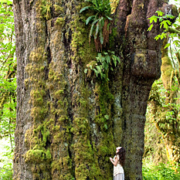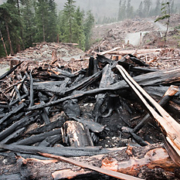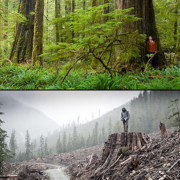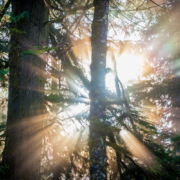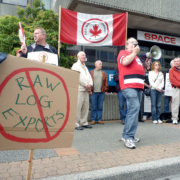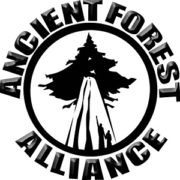Near the end of a December day last year, TJ Watt, a long-time environmentalist, discovered a seemingly overlooked area of old growth forest only 15 minutes from Port Renfrew on the west coast of Vancouver Island.
Watt has actively campaigned for the protection of BC’s old growth forests for many years. On this occasion, he had embarked on a two-day hike to explore the Gordon River valley in search of any remaining old growth forest — or at least remnants, in the form of giant tree stumps. As darkness fell on the second day, what he found was truly special.
Spotting the tell-tale forked tops of old growth cedars on a hillside, Watt and a friend hiked deeper into the woods. “As soon as we stepped into the forest we knew we had found something exceptional,” he recalls. “We’ve lost 96 percent of the valley bottom old-growth on southern Vancouver Island so to find an area like this within the remaining four percent — and have it be so close to town and a paved road — was just unbelievable.”
The gigantic Douglas firs, cedars, and hemlocks found in old growth forests are valuable commodities for the logging companies. The valley bottoms are the most easily accessible for logging, so most of those trees have been harvested already. Companies then turn to harvesting the hills or mountainsides. Outside Port Renfrew, the surrounding area had been logged, but somehow this 10 hectare plot had been left standing.
Within weeks, Watt and other prominent local activists created the Ancient Forest Alliance, a group that has since grown to 8000 members. Ken Wu, the group’s campaign director, is no stranger to the old growth forest issue. It was his idea to name this area of the Gordon River valley, “Avatar Grove”.
The name was a clever move to capitalize on the popularity of the James Cameron film, Avatar. But the connection was much deeper. “If you’ve seen the film, you can see it’s about protecting old growth forest,” Wu insists. Even the forest scenes with its giant ferns and big trees resembled BC’s old growth forests.
Despite the uniqueness of Avatar Grove, this rare patch of old growth forest appeared to be in jeopardy. When Watt returned to the site two months later, he found the area had been flagged for logging and road development.
A Surrey, BC, logging company, Teal Jones, has permission to harvest trees on 60,000 hectares on land in the Gordon River valley. The province granted permission through tree farm licence (TFL) 46. Despite appeals to the BC Ministry of Forests to save Avatar Grove, the government has taken no action to halt logging. A Teal Jones representative says the company has not yet made a decision to cut down those trees.
The Ancient Forest Alliance wants the Ministry to make Avatar Grove and the surrounding 90 hectares off-limits to logging. “The Avatar Grove presents the finest opportunity for the public to easily gain access world class old-growth forest, in a wilderness setting on flat gentle terrain,” says Watt. “It contains dozens of giant alien-shaped red cedars, some measuring up to 13 feet across, as well as rare old-growth Douglas fir — and it’s already becoming the Cathedral Grove of Port Renfrew.”
Cathedral Grove, located on the highway near Port Alberni on Vancouver Island, attracts one million visitors a year, says Watt. The road is regularly the site of traffic jams as buses, cars, and campers pull over to park. Trails allow visitors to wander through this preserved old growth forest and marvel at the circumference and height of these forest giants.
Avatar Grove, he says, has the potential to attract just as many tourists to Port Renfrew, and thereby stimulate the local economy.
West Coast old growth forest consists of giant Sitka spruce, Douglas fir, western hemlock, and both red and yellow cedar trees. Protecting these forest giants is more than a matter of keeping a few big trees for tourists to view. Old growth forests support a level of biodiversity not found in second growth forest. The giant trees are also valuable as carbon “sinks”, absorbing harmful greenhouse gases that are a factor in global warming.
Eighty percent of productive forest land in BC southern coast is already second growth. To complaints that protecting old growth forest will cost forest industry jobs, Wu counters, “The total transition to second growth trees is inevitable. Why not do it now, instead of waiting until all the unprotected old-growth forest is gone?”
The “jobs versus tourism” conundrum often plagues logging communities, where saving trees may be regarded as sacrificing vital jobs. Past confrontations between loggers and environmentalists show what happens when people see their livelihoods threatened.
Logging Avatar Grove, Wu explains, would provide a few months’ work for half a dozen people. On the other hand, preserving the space as a tourist attraction would create a sustainable source of income for Port Renfrew indefinitely.
Watt says, “The Port Renfrew Chamber of Commerce is in full support of having the area protected and local businesses are already seeing the increased traffic from those who come to town because of the trees.”
The Ancient Forest Alliance is circulating a petition to pressure the BC government into protecting not just Avatar Grove, but all areas in the province where old growth forest is rapidly disappearing due to logging. The group hopes to collect 100,000 names to show the extent of its public support.
Until then, curiosities like Canada’s “gnarliest” tree are at risk of being cut down. A redcedar in Avatar Grove was given this unofficial distinction because of a burl on its trunk of over 12 feet across, giving the tree an alien-like appearance, as Watt’s many photographs reveal.
Watt says, “If the Avatar Grove is lost, Port Renfrew won’t get another chance like this for another thousand years.”


